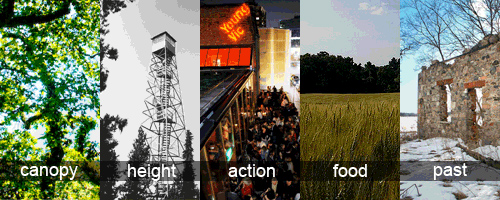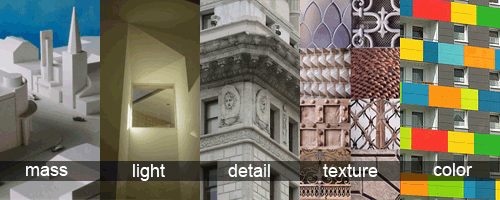Inspiration
Having traveled domestically and abroad, always living in Pennsylvania, the verdant forests and hills of our state, the urban centers, the farmed valleys, and the historical architecture are touchpoints for design. Canopies, height, action, food, and the past are symbols of domestic life.

We seek shelter for warmth in the winter, and protection from storms.
Humans desire to reach for the heavens and gaze upon the land. Social events drive us to interact and exchange ideas. The communal event of dining enriches our bodies and our spirit. Previous achievements highlight our past accomplishments and connect us to our heritage. In concert, these five elements are brought in each design to a symphony of massing, light, detail, texture, and color.

The photographs shown touch on so many facets of the art of architecture that have guided and enlightened me throughout my growth as a designer. Ancient, medieval, classical, baroque, colonial, modern, and contemporary are just a few of the multitude of styles that I have visited and gained a respect for the time, location, and reason for each structure. These three concepts are vital to growing as a designer. How architects have handled the need for shelter, their available technologies, and their environment has produced millions of correct answers for the same question in life; Residential Architecture. Similar to the quest for the great American novel, there is no one defining style for American dwellings. City life, farm life, green suburbs, extremes in heat and cold have; each has responded in a localized anomly, seperate from other regions. Through these countless permutations, we as architects in America have a great and varied past from where we can be influenced in design. Being a student of the history of architecture, not just a contemporary architect, I see the connections and reasonings of the buildings to their surroundings and era in which they were built. I also study how and why structures were built to utilize the proper volumes, styles, and details for a given time in history.
Inspiration also comes from other art forms. Painting and music are similar to architecture due to the timeframe composed and reflection of the culture surrounding each artist. The DiStijl movement informs painting, music, and architecture in similar manners, stripped down to base elements of color, shape, and volume. These art forms utilized this concept to create stunning works, now is a time to revive this idea with historical connections. The White Stripes are a well known,influential, and successful "garage band." By stripping away the extra layers of studio production, excessive instrumentation, and overdubbed voices, the White Stripes have adopted DiStijl in spades. The resulting music is not robotic or foreign, it is a set of drums, a guitar, and a voice, singing from the American Mid-west. These three same elements used in any other part of the country or world would have distinct sounds influenced by their regional culture. Architecture needs this reset of DiStijl of form, pattern, and texture, not in a modern sense, but connecting with our regional traits. This contemporary vernacular architecture style is what I strive to create for my
clients.
The process of Architectue yields a product, the building. Similar to everyday consumer goods, basic economics dictates that good products, in our case buildings, are items consumers buy from manufacturers, or builders, angling to make a profit. Architecture and building does create a profit, but the importance of the built environment is to the benefit of the community. What makes a building successful is not one, but many aspects; a balancing act of form and function that enables the product to (1) serve an umnet need, (2) be easy to use, (3) be attractive, and (4) be efficient to produce.
Six other important concepts are included in the process of design: Charettes, design process to solve programmatic problems. In Situ, the materials in the location where the building will be built. Hierarchy of Needs, a pyramid based system describing how are needs are met. Basic needs such as food or complex facets such as morals. Open Design, used to describe collaborative creation of new products. Poka-yok, a term from Japan, ensuring products are used in the manner for which they were designed. TIMTOWTDI, There Is More Than One Way To Do It, several options will solve the same problem.
At BHA, the Design phase combines of the above concepts into three distinct portions of the design phase, Function, Design, and Cost.
Function, the clients' needs must be met for the program to be adopted and be utilized in a rational manner, resolving space, relationships, and shape of spaces.
Design, is defined by the style, quality of finishes, methods of construction, systems employed, and features included in the project.
Cost, portrays the monetary and time value dedicated to a project.
Inspiration also comes from contemporaries in the field of architecture. Author/architects seem plentiful, feeling that the built environment is not getting enough interest from the general population, books tout small, economic design,accurate detailing, and forming the proper house. Sarah Susanka and Jeremiah Eck are two great architects working to bring the form, size, and detailing together in an outstanding product. Further reading on these designer/authors can be found at your local bookstore or library.




